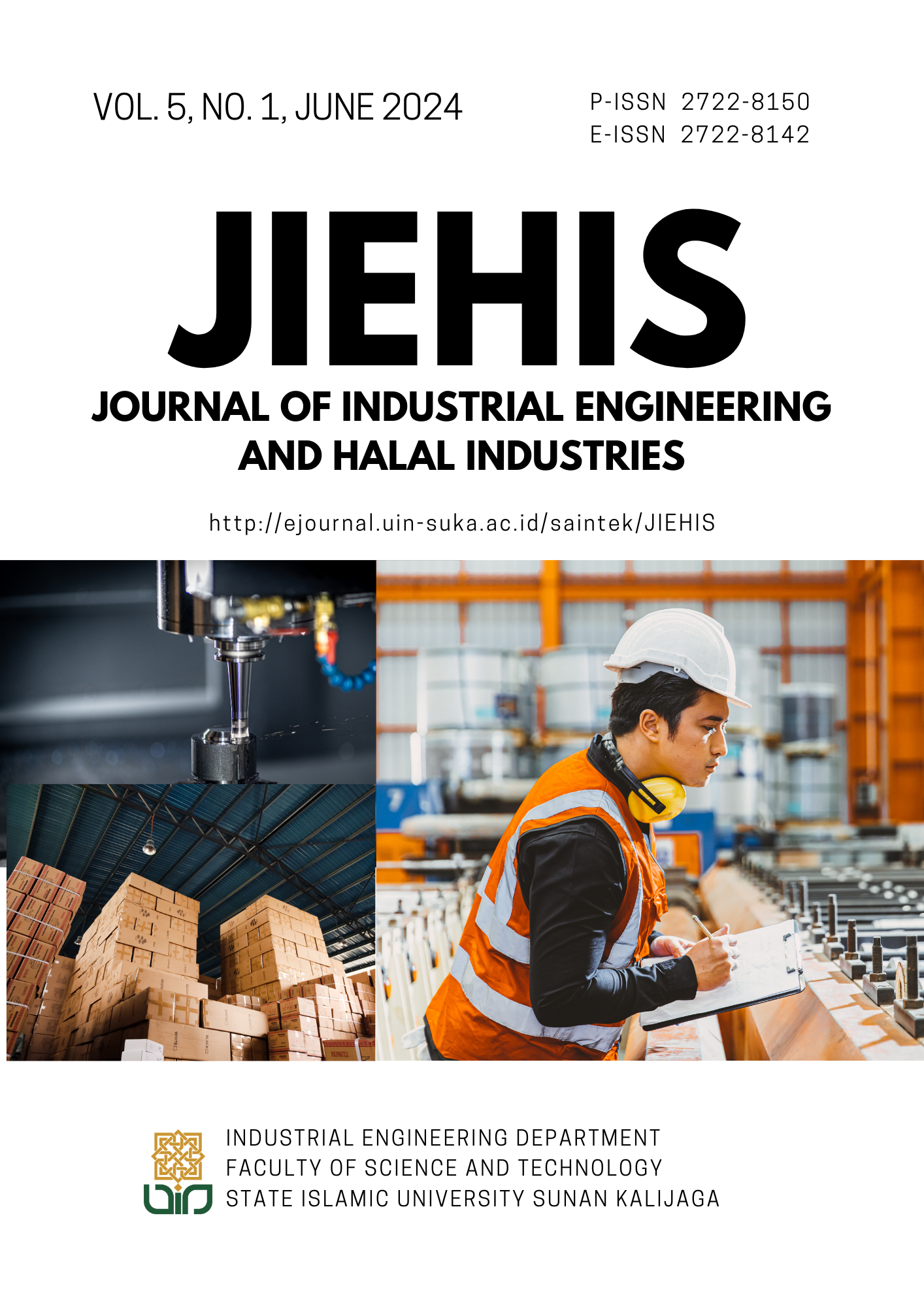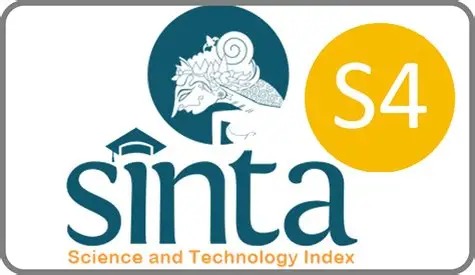Transforming Tofu Quality Control: Integrating Statistical Process Control, Ishikawa, and Interpretive Structural Modeling for Superior Outcomes
Integrating Statistical Process Control, Ishikawa, and Interpretive Structural Modeling for Superior Outcomes
DOI:
https://doi.org/10.14421/jiehis.4685Keywords:
Statistical Process Control (SPC), Ishikawa diagram, Interpretive Structural Modeling (ISM) , defects , control qualityAbstract
In a highly competitive market, maintaining high product quality is essential for maintaining customer satisfaction and loyalty. Producers are famous in East Java and face the challenge of ensuring consistent quality products through strict production processes. Know that as easy products broken and soft, needy control of careful quality to meet hope consumers about freshness, texture, and quality in a way whole. Although traditional control methods often fail to overcome the production complex that causes a disabled product. This research proposes integrating Statistical Process Control (SPC), Ishikawa diagrams, and Interpretive Structural Modeling (ISM) to improve control quality. SPC makes it possible to monitor and control production processes in real-time, identify deviations, and repair deviations. However, the SPC limitations include a focus on quantitative data and post-incident detection problems. To overcome root problems, the Ishikawa diagram categorizes the reasons for potency as material, machine, method, power work, and environment. ISM prioritizes action repair based on impact and relationship. Approach This integrated approach provides comprehensive solutions to improve the quality of knowledge. In this study, the control process quality was evaluated using SPC, the cause of defects was identified using Ishikawa diagrams, and priority action repair was performed via ISM. Findings show that SPC directly effectively monitors process control, the Ishikawa diagram identifies main defects, and ISM prioritizes impactful action improvements, emphasizes excessive additions to subtraction materials, and improves health workers’ and mixing process material standards. Approach integrated possible identification of additional problems and improved the quality strategic makes a significant contribution to enhancing product quality knowledge.
References
Ahmad, N., & Qahmash, A. (2021). SmartISM: Implementation and Assessment of Interpretive Structural Modeling. Sustainability, 13(16), 8801. https://doi.org/10.3390/su13168801Handayani, D. I., Masudin, I., Susanty, A., & Anna, I. D. (2023). Modeling of halal supplier flexibility criteria in the food supply chain using hybrid ISM-MICMAC: A dynamic perspective. Cogent Engineering, 10(1), 2219106.
Alves De Melo, G., De Castro Júnior, L. G., Mendonça Peixoto, M. G., Angélico Mendonça, M. C., & Borges Barbosa, S. (2022). Statistical quality and process control in an organization of the food sector located in the Alto Paranaiba mesoregion. DYNA, 89(224), 9–16. https://doi.org/10.15446/dyna.v89n224.102480
Attri, R., & Grover, S. (2017). Modelling the quality enabled factors in initiation stage of production system life cycle. Benchmarking: An International Journal, 24(1), 163–183. https://doi.org/10.1108/BIJ-12-2014-0113
Colledani, M., Tolio, T., Fischer, A., Iung, B., Lanza, G., Schmitt, R., & Váncza, J. (2014). Design and management of manufacturing systems for production quality. CIRP Annals, 63(2), 773–796. https://doi.org/10.1016/j.cirp.2014.05.002
Dahlan, M., Rauf, N., & Nusran, M. (2023). Interpretural structural modeling of performance improvement strategies on perception of customers. 15(2).
Handayani, D. I., Masudin, I., Susanty, A., & Anna, I. D. (2023). Modeling of halal supplier flexibility criteria in the food supply chain using hybrid ISM-MICMAC: A dynamic perspective. Cogent Engineering, 10(1), 2219106.
Kamizake, N. K. K., Silva, L. C. P., & Prudencio, S. H. (2018). Impact of soybean aging conditions on tofu sensory characteristics and acceptance. Journal of the Science of Food and Agriculture, 98(3), 1132–1139. https://doi.org/10.1002/jsfa.8564
Kazancoglu, Y., Ozbiltekin-Pala, M., Sezer, M. D., Ekren, B. Y., & Kumar, V. (2021). Assessing the Impact of COVID-19 on Sustainable Food Supply Chains. Sustainability, 14(1), 143. https://doi.org/10.3390/su14010143
Khaba, S. (2023). Analysis of Bottleneck using Mine Production Index and Ishikawa Diagram: A case of Indian Coal Mine. Bilimsel Madencilik Dergisi. https://doi.org/10.30797/madencilik.1160266
Kumar, A., & Dixit, G. (2018). An analysis of barriers affecting the implementation of e-waste management practices in India: A novel ISM-DEMATEL approach. Sustainable Production and Consumption, 14, 36–52. https://doi.org
Knop, K., & Gejdoš, P. (2024). Analysis of the Impact of Machinery Modernization on Casting Quality Using Quality Management Tools. Manufacturing Technology, 24(2), 207–218. https://doi.org/10.21062/mft.2024.036
Laghouag, A., Zafrah, F. B., Qureshi, M. R. N. M., & Sahli, A. A. (2024). Eliminating Non-Value-Added Activities and Optimizing Manufacturing Processes Using Process Mining: A Stock of Challenges for Family SMEs. Sustainability, 16(4), 1694. https://doi.org/10.3390/su16041694
Pal, B., Pal, A., Das, S., Palit, S., Sarkar, P., Mondal, S., Mallik, S., Goswami, J., Das, S., Sen, A., & Mondol, M. (2020). Retrospective study on the performance of a constancy check device in Linac beam monitoring using Statistical Process Control. Reports of Practical Oncology & Radiotherapy, 25(1), 91–99. https://doi.org/10.1016/j.rpor.2019.12.004
Singh, S., Barve, A., & Shanker, S. (2021). An ISM-gDEMATEL framework for assessing barriers to green freight transportation: A case of Indian logistics system. International Journal of Sustainable Engineering, 14(6), 1871–1892.
Skorupińska, E., Hitka, M., & Sydor, M. (2024). Surveying Quality Management Methodologies in Wooden Furniture Production. Systems, 12(2), 51. https://doi.org/10.3390/systems12020051
Tsenev, V. (2021). Use of SPC (Statistical process control) for Quality Control and Management of an Automatic Production Line. 2021 12th National Conference with International Participation (ELECTRONICA), 1–4. https://doi.org/10.1109/ELECTRONICA52725.2021.9513725
Veltmeyer, J., & Mohamed, S. (2017). Investigation into the hierarchical nature of TQM variables using structural modelling. International Journal of Quality & Reliability Management, 34(4), 462–477. https://doi.org/10.1108/IJQRM-04-2015-0052
Wittenberger, G., & Teplická, K. (2024). The Synergy Model of Quality Tools and Methods and Its Influence on Process Performance and Improvement. Applied Sciences, 14(12), 5079. https://doi.org/10.3390/app14125079
Wiederhold, M., Greipel, J., Ottone, R., & Schmitt, R. (2016). Clustering of similar processes for the application of statistical process control in small batch and job production. International Journal of Metrology and Quality Engineering, 7(4), 404. https://doi.org/10.1051/ijmqe/2016018
Zaloga, V., Dyadyura, K., Rybalka, I., Pandova, I., & Zaborowski, T. (2020). Enhancing Efficiency by Implementation of Integrated Management System in Order to Align Organisational Culture and Daily Practice. Management Systems in Production Engineering, 28(4), 304–311. https://doi.org/10.2478/mspe-2020-0043
Zan, T., Liu, Z., Su, Z., Wang, M., Gao, X., & Chen, D. (2019). Statistical Process Control with Intelligence Based on the Deep Learning Model. Applied Sciences, 10(1), 308. https://doi.org/10.3390/app10010308
Downloads
Published
How to Cite
Issue
Section
License
Copyright (c) 2024 DWI IRYANING Handayani

This work is licensed under a Creative Commons Attribution-ShareAlike 4.0 International License.
(c) The Author(s). This article is distributed under a Creative Commons Attribution-ShareAlike 4.0 International License.






